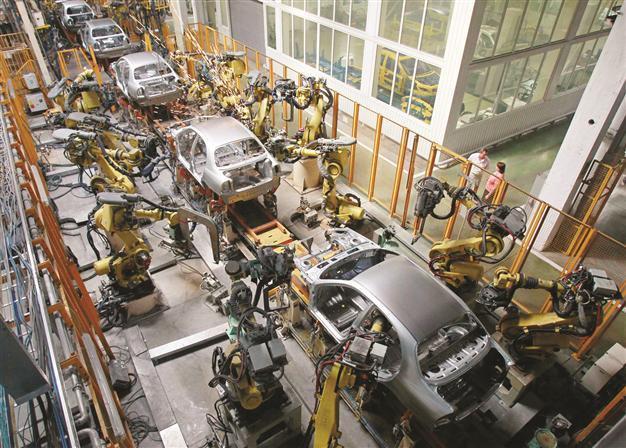US, EU auto industries pull out of stagnation
PARIS - Agence France- Presse

Robot arms assemble cars at the Avto ZAZ plant, major Ukrainian car maker. Without clear indications, European market has been hinting recovery. REUTERS photo
Car industries in the United States and Europe are showing clear signs of getting back on track after severe setbacks in the financial and debt crises.
The US auto market returned to pre-crisis levels in July and the slump in European sales seemed to ease.
US car sales reached the best levels for seven years as American consumers are being encouraged by low interest rates and a boom in the shale oil and gas industry.
A closely watched indicator, the sales adjusted annualised rate (SAAR), gave a reading of 15.67 million units, allowing the sector to return to the volumes it knew before the 2007 global financial crisis that crippled the sector.
It’s a stunning recovery from a deep and painful downturn which pushed General Motors and Chrysler into bankruptcy in the wake of the 2008 financial crisis and which forced the American auto industry to undergo massive restructuring.
Both GM and Ford last month reported better-than-expected results for the quarter while Chrysler inflated the earnings of its parent company Fiat.
The Japanese -- key players on the US car market -- are also faring well.
Boosted by a fall of the yen, the leading world automaker Toyota raised its annual forecast despite a fall in global sales. Nissan, on the other hand, confirmed its targets even though its number of registrations fell.
Europe has also experienced a sunnier spell, even though the debt-burdened continent has been much slower to restructure its auto sector as governments pull the breaks in fear of higher unemployment if plants are shut down.
Earlier this month, BMW said weak European markets and higher competition would continue to provide challenges in the second half of the year.
In July, registrations in Germany rose by 2.1 percent, while Spain experienced a 14.8 percent rise, although this was with the help of government subsidies for the replacement of an old car with a new one.
Such temporary schemes in other European countries to support the auto industry after the financial crisis were followed by a slump in sales.
But overall, the latest numbers may mean that the drop in EU registrations is slowing down.
In the first quarter the figure fell by 6.6 percent compared with a year earlier -- but numbers to confirm a trend will not be available until September.
An up-tick would do wonders for car makers such as France’s PSA Peugeot Citroen, which is still highly dependent on Europe and which has managed to cut its quarterly debt in almost half.
The group, which has in effect been rescued via government help for its credit arm, said it was pulling out of the worst part of its crisis and had no plans now to raise new capital.
But other European players which focused more on the international market are still doing better, such as French firm Renault and in particular German auto manufacturers like Daimler, BMW and Volkswagen -- all reporting solid second-quarter results.
Still, analysts and car makers alike are preparing for a near 5.0-percent drop on the European market this year from the already depressed level last year.
Industry forecaster IHS Automotive said it does not expect the French market to return to pre-crisis levels until 2017, and forecasts sales in Spain and Italy to remain at very low levels.
Slowing sales, big prospects in Russia Aside from the US market, hope is mainly pinned on emerging markets and in particular China -- the world’s biggest auto market now dominated by American, German and Japanese car makers.
In the first half of the year, sales there surged by 12.3 percent to 10.78 million.
Russia, which in a few years could overtake Germany to become Europe’s biggest market and last year accounted for a record 2.93 million car sales, has experienced a drop in sales for several months as economic growth in the country slows.
On Aug. 8, the Association of European Businesses (AEB) said Russian car sales plunged 8.0 percent in July compared with a year earlier, but said it expected the market to “stabilise” in the coming months.
Nissan is one of the players that have expanded considerably in Russia and the group’s chief executive Carlos Ghosn recently said he was certain the Russian auto market would take off in the long term.
India has similarly experienced both highs and lows. At the end of June it had experienced eight months of declining registrations.
Business advisory firm AlixPartners forecasts that 2.6 million cars will be sold in India in 2018, compared with 1.9 million in the 2012-2013 fiscal year which finished at the end of March.
